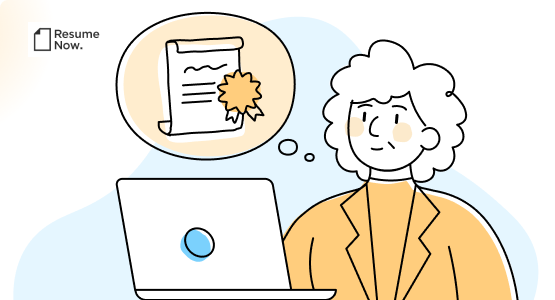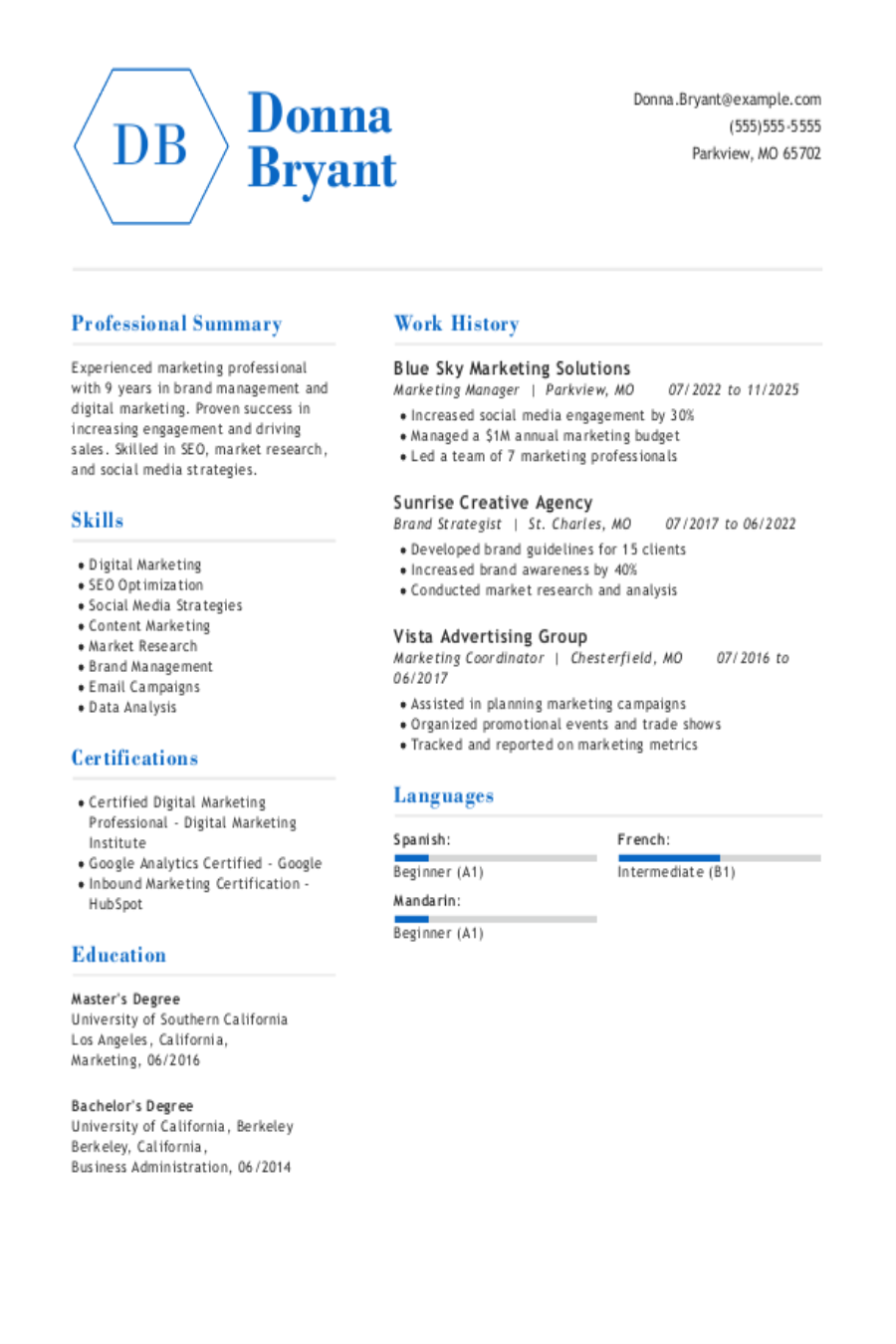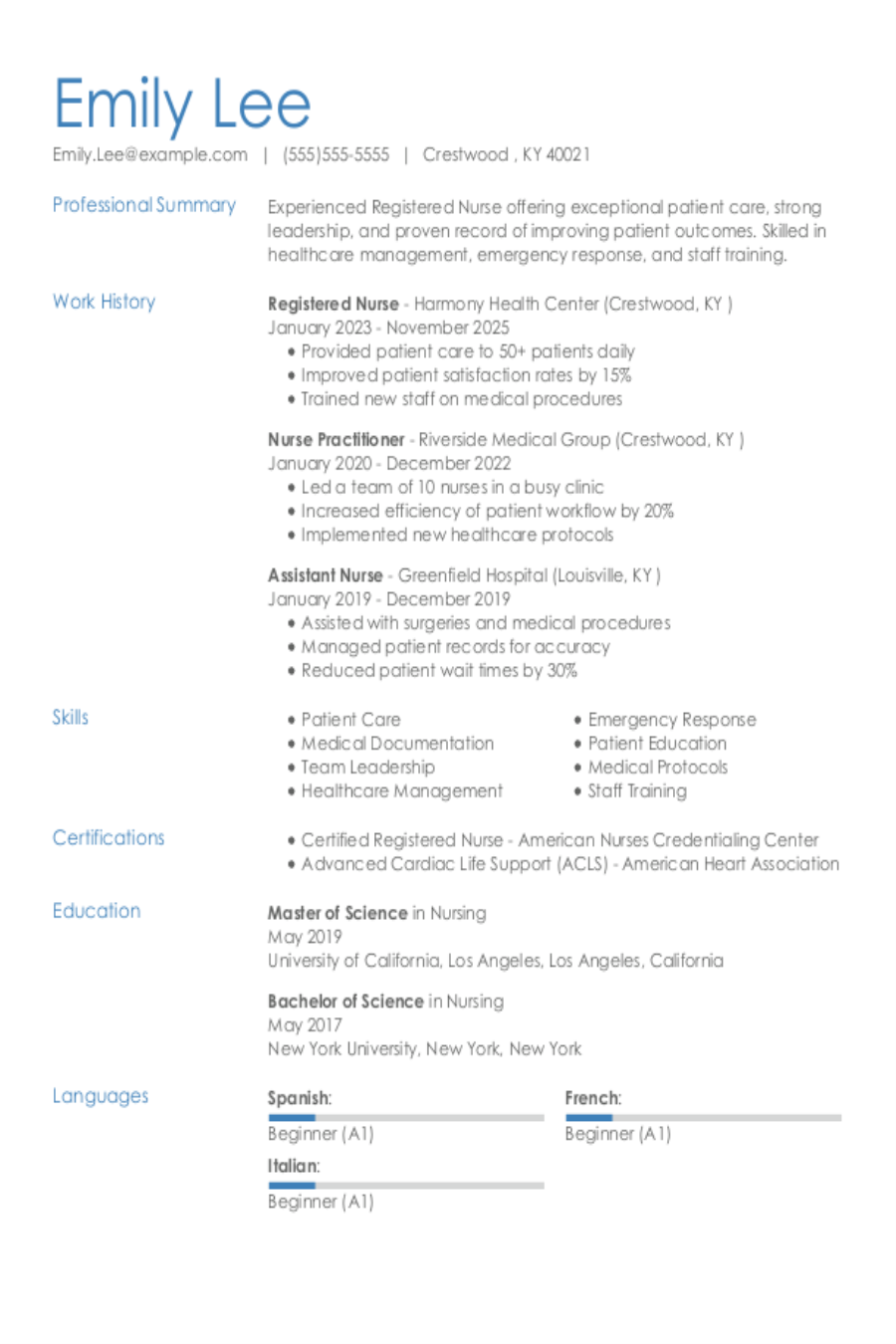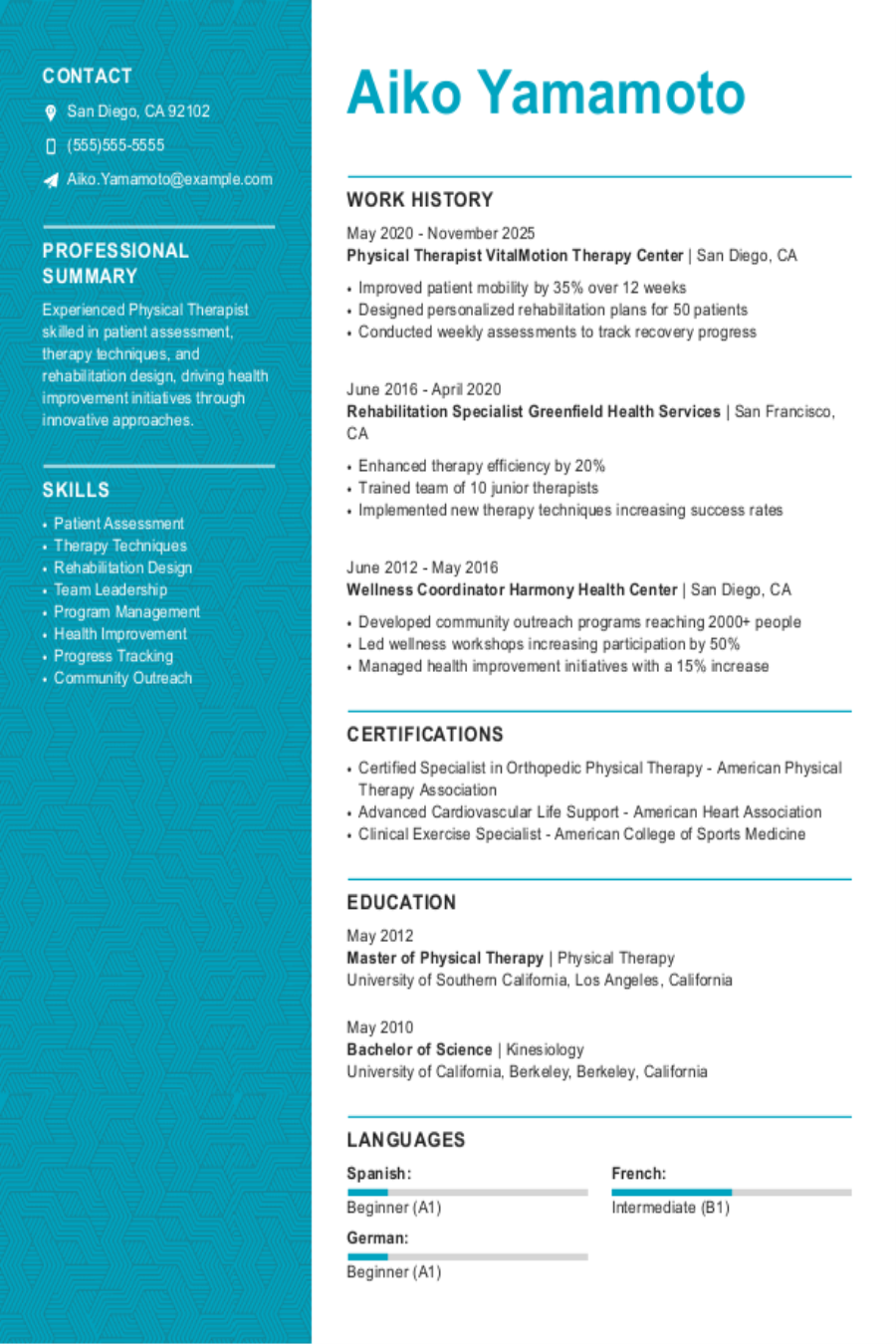Popular Art Director Resume Examples
Entry-level art director resume
An entry-level resume for an art director should focus on showcasing creative skills, relevant projects, internships, design software skill, and a strong portfolio to demonstrate potential and vision.
Places skills over experience: Using a functional resume format highlights this candidate's leadership in art projects and creative direction skills, rather than focusing on chronological work history.
Focuses on goals: The applicant demonstrates a strong foundation in art direction and brand management, showcasing their commitment to ongoing professional development through leadership roles and successful project outcomes.
Mid-career art director resume
A mid-career art director's resume should emphasize a strong portfolio, leadership in creative projects, and the ability to adapt skills to meet evolving industry trends and client needs.
Begins with a powerful summary: This resume's professional summary highlights the applicant's dynamic leadership and design expertise, emphasizing a proven ability to boost brand engagement.
Includes mix of skills: This resume highlights a perfect mix of hard skills like Adobe Creative Suite skill and project management, alongside soft skills such as team leadership and creative direction.
Experienced art director resume
An experienced art director resume should emphasize creative achievements and leadership roles, clearly illustrating the job seeker's growth and impact in the design industry.
Embraces modern design: This modern resume template showcases the art director's creative leadership and innovative vision, emphasizing their ability to improve project efficiency and client satisfaction in a visually engaging manner.
Optimized for ATS: This resume uses a polished template that merges a professional header with an ATS-friendly resume structure, ensuring optimal clarity and accessibility for both hiring managers and automated screening systems.
More resume examples
Art Director Resume Template
Kickstart your creative journey with this art director resume template. You can easily adapt it to showcase your unique skills and experiences in the field.
Michael Johnson
Lakeside, CA 92051
(555)555-5555
Michael.Johnson@example.com
Professional Summary
Accomplished Art Director with a track record of enhancing brand identity through innovative design strategies. Expertise in leading teams to achieve measurable improvements in engagement and sales. Proficient in Adobe Creative Suite and creative strategy.
Work History
Art Director
CreativeVision Studios - Lakeside, CA
March 2024 - October 2025
- Led a team to increase ad engagement by 30%
- Developed campaign visuals boosting sales by 20%
- Reduced design production time by 25% with new strategy
Senior Graphic Designer
Innovate Creations Co. - Riverside, CA
May 2023 - February 2024
- Optimized branding projects for a 40% budget cut
- Enhanced website UX, increasing traffic by 15%
- Collaborated on cross-functional teams for product launches
Visual Design Specialist
DesignHub Media - Los Angeles, CA
May 2021 - April 2023
- Spearheaded design revamp, increasing conversions by 10%
- Coordinated with clients, achieving a 90% satisfaction rate
- Mentored junior designers, improving team quality by 35%
Skills
- Graphic Design
- Art Direction
- Creative Strategy
- Brand Development
- Digital Marketing
- UX/UI Design
- Team Leadership
- Adobe Creative Suite
Education
Master of Fine Arts Visual Communication
University of California, Berkeley Berkeley, California
May 2021
Bachelor of Arts Graphic Design
University of Washington Seattle, Washington
June 2019
Certifications
- Advanced Graphic Design - Creative Arts Institute
- Art Direction Excellence - International Design Group
Languages
- Spanish - Beginner (A1)
- French - Beginner (A1)
- German - Beginner (A1)
Must-Have Skills on a Art Director Resume
A strong skills section is important for creating a strong resume.
Creative and design professionals transform ideas into visual experiences that engage and captivate. The skills you highlight should show how you bring originality and thoughtful insight to projects. Your resume lets you demonstrate your role in shaping meaningful, memorable work that supports broader goals.
The following data outlines the most prevalent hard and soft skills relevant to an art director according to Resume Now’s internal resume data.
When you're ready to improve your resume with key skills, check out our AI Resume Skills Generator. It recommends both hard and soft skills tailored to your job title, helping you create a comprehensive and personalized skill set.
Writing Your Art Director Resume
Having explored these compelling resume examples, you are now set to dive into the process of writing your own resume. We will guide you step by step through each section, ensuring you understand how to write a resume that stands out.
List your most relevant skills
As an art director, your skills section should highlight both your design expertise and soft skills such as leadership and collaboration. Tailoring this section with relevant keywords from the job listing can improve the impact of your resume, demonstrating that you possess the qualities employers value.
Using these keywords not only aligns your qualifications with the specific requirements of the role but also helps you get noticed by applicant tracking systems. By incorporating terms like "visual communication," "team management," and "concept development," you increase your chances of catching the eye of hiring managers while ensuring you meet screening criteria effectively.
Example of skills on an art director resume
- Creative with a strong portfolio showcasing diverse design projects
- Proficient in various design software including Adobe Creative Suite
- Collaborative team player who values feedback and communication
- Strong attention to detail with a passion for visual storytelling
Your skills section is important for demonstrating your readiness for the art director role. Highlight both the technical skills mentioned in the job description and relevant soft skills. This combination showcases your ability to meet the position's demands effectively and creatively.
Highlight your work history
Your work experience section is should focus on including specific accomplishments that highlight how you’ve driven projects and contributed to a team's success. Use strong language and industry-specific keywords to ensure your experiences resonate with hiring managers.
For each job entry, be sure to include key details: your job title, the name of the employer, and the dates of employment. This information helps employers quickly assess your background and professional credibility. Remember to emphasize notable projects or campaigns that demonstrate your ability to lead design initiatives effectively.
Example of an art director work experience entry
- Art Director
Creative Agency - San Francisco, CA
January 2021 - Present - Lead a team of designers in the development of creative concepts for branding and advertising campaigns, resulting in a 30% increase in client engagement
- Oversee the production process from concept to completion, ensuring high-quality visual output that aligns with client expectations and deadlines
- Collaborate with cross-functional teams, including marketing and copywriting, to create cohesive project strategies that improve brand storytelling
- Mentor junior designers, providing constructive feedback that improved their design skills and boosted overall team productivity by 25%
- Conduct regular design critiques to uphold creative standards while fostering an innovative environment that encourages fresh ideas
Quantifying achievements as an art director is essential for illustrating your impact on project success. For example, noting that you led a campaign that resulted in a 40% increase in engagement rates can effectively highlight your creative contributions to potential employers.
Add portfolio work to your resume
For art directors, showcasing your creative vision on your resume is important while inviting employers to explore your full portfolio.
Place a direct link to your online portfolio at the top of your resume, ensuring it’s easily accessible. Include a section titled project highlights that highlights 3-4 standout projects with brief descriptions that emphasize design impact and collaboration. Use bullet points for clarity, making sure that each entry speaks to specific results or achievements.
Example of a portfolio highlights section
- Ad Campaign for Bright Future NGO – Developed a visually striking campaign that raised awareness and increased donations by 50%
- Product Packaging Design for EcoGoods – Created sustainable packaging that improved brand appeal, leading to a 20% sales growth
- Website Visual Redesign for Fashion Hub – Revamped site aesthetics, improving user engagement metrics by 35%
- "Cityscapes" Art Exhibition – Curated and displayed work at local gallery, attracting over 200 visitors in the opening week
Include your education
The education section of your art director resume should display your academic qualifications in reverse-chronological order, starting with the most recent degree. Include any relevant diplomas and certifications while omitting your high school diploma if you have obtained a bachelor's degree or higher.
For those currently pursuing a degree or with incomplete education, list the highest level completed and include an expected graduation date. You may add bullet points to outline relevant coursework or notable achievements that relate directly to the role of an art director. This approach is particularly useful for students or recent graduates as it helps showcase their educational background.
Common certifications for an art director resume
- Certified Art Director (CAD) – Art Directors Guild
- Adobe Certified Expert (ACE) – Adobe Systems
- Professional Certified Marketer (PCM) – American Marketing Association
- Certified Graphic Designer (CGD) – Society of Graphic Designers
Sum up your resume with an introduction
Crafting a compelling profile section is essential for your resume, as it serves as your first impression for potential employers.
For seasoned professionals in the creative field, a professional summary is particularly effective. It allows you to highlight significant achievements and relevant experiences that demonstrate your expertise. If you lack extensive work history, try a resume objective that reflects your goals and enthusiasm for development.
Professional summary example
Creative art director with over 10 years of experience in leading dynamic design teams across diverse industries. Proven ability to elevate brand identity through innovative visual storytelling and strategic concept development. Highly skilled in project management, digital design, and client collaboration, ensuring projects are delivered on time and exceed expectations.
Resume objective example
Passionate art director eager to bring fresh creativity and a keen eye for detail to an innovative design team. Ready to harness strong visual storytelling and collaborative skills to elevate brand aesthetics and drive strong campaigns.
As an art director applicant, your resume profile should be concise and packed with key information. Aim for three sentences that highlight your most relevant skills and experiences. If you have more to share, consider including it in your cover letter for a fuller picture of your qualifications.
Add unique sections to set you apart
Optional resume sections are a fantastic way for you to highlight your unique qualifications as an art director. These sections allow you to stand out by showcasing skills and experiences that may not be covered in the main parts of your resume.
By including relevant hobbies or volunteer work, you provide insight into your professional persona. This can demonstrate your commitment to creativity, collaboration, and community engagement. Employers appreciate seeing how you apply your artistic talents outside of work, revealing a well-rounded character that aligns with their values.
Three sections perfect for a art director resume
- Work Samples: A portfolio section is essential for an art director's resume, providing a visual testament to your creativity and leadership. Showcase 3-5 standout projects with concise descriptions of your vision, execution, and the impact on the overall design narrative.
- Client Testimonials: Incorporating client testimonials into your resume can showcase your creativity and impact. Select a few concise quotes that emphasize your innovative solutions, commitment to quality, and the positive experiences clients have had working with you.
- Awards and Recognition: Including awards on your resume can improve your appeal to potential employers. Highlight notable achievements, such as industry accolades or project honors, with details about the awarding body and year to showcase your excellence.
5 Resume Formatting Tips
- Choose a format that matches your career stage.
When selecting a resume format, consider your career level and experience. If you have extensive experience, a chronological format highlights your career progression effectively. For those starting out or switching fields, a functional format focuses on skills rather than job history. A combination format can also highlight both skills and experience for a balanced approach.
- Pick a smart resume template.
Using a professional resume template is essential for effectively showcasing your skills. It improves readability and ensures that hiring managers can easily digest your information. If you prefer to create your own layout, keep it clean and opt for fonts that are compatible with applicant tracking systems.
- Select an appropriate font.
Choose a professional font like Helvetica or Garamond to improve your resume's visual appeal and readability.
- Use consistent formatting.
Ensure your resume is neatly aligned, with uniform margins. This creates a polished and professional look that improves readability and makes a great first impression.
- Keep your resume to one or two pages.
When crafting your resume, remember that resumes should be one page long for most professionals. Keep your content concise and targeted to showcase your skills and experiences effectively. This approach ensures that potential employers can quickly grasp your qualifications.
Tools for Your Job Search
Are you ready to pursue your dream role as an art director? Before sending out your application, consider using our ATS Resume Checker. This powerful tool provides essential feedback on how well your resume aligns with the automated systems that many creative agencies use for initial screening.
Looking for a way to improve your resume further? Our AI Resume Builder offers tailored content recommendations designed specifically for your artistic background, along with professionally crafted templates that showcase your portfolio and creative skills effectively.
Frequently Asked Questions
Last Updated: October 16, 2025
Absolutely. A cover letter is important because it provides additional context to your resume and fosters meaningful communication with potential employers. It’s your opportunity to convey your passion for the art director role and highlight how your unique experiences make you an ideal applicant. So, don’t hesitate—write a cover letter that showcases your creativity and vision.
For a hassle-free way to create a tailored cover letter, try our AI Cover Letter Generator. In just minutes, you can produce a standout cover letter and choose from various cover letter template options that align perfectly with your resume, ensuring consistency in your application materials.
A resume is typically a concise document, spanning one to two pages, while a curriculum vitae (CV) can extend several pages and includes comprehensive details about your academic background, research contributions, publications, and professional experience. This means that if you're applying for a role that requires in-depth information about your qualifications, a CV is the appropriate choice.
CVs are often required for positions in academia, science, law, and medicine. If you find yourself needing to create a CV for such roles, consider using our online CV Maker. It allows you to quickly generate tailored CVs with various CV templates suited for different industries and career levels—making the process efficient and user-friendly.
For an impressive art director resume, select a modern, professional template and integrate keywords from the job description. This strategy showcases your creativity and aligns your skills with the employer's needs.
Absolutely, important skills like "creative vision" and "team collaboration" are highly sought after on art director resumes. Be sure to examine job descriptions for other essential keywords and phrases that employers prioritize.
To craft a compelling skills section as an art director, mix your technical abilities in design software with soft skills like leadership and communication. Illustrate how you've applied these skills in past projects to achieve outstanding visual outcomes, showcasing your creativity and ability to guide teams effectively.
Stay ahead in your career as an art director by pursuing continuous learning opportunities. Consider obtaining relevant certifications, joining industry associations, and engaging with community events. Additionally, keep yourself updated on design trends through blogs and podcasts to improve your skills and knowledge.
Was this information helpful? Let us know!
Hailey is a career advice writer dedicated to helping job seekers excel in their careers.
More resources

Still in the Game: 9 in 10 Older Workers Are Upskilling to Stay Competitive
The idea that older workers are resistant to change doesn t ho...

The AI Boss Effect: 97% of Workers Have Asked ChatGPT for Advice Instead of Their Manager
Resume Now s latest report explores how AI is replacing manage...

37 Unique Skills to Put on Your Resume
Trying to avoid the skills you see pop up on resumes repeatedl...

Marketing Resume: Examples, Templates & Tips
Need a marketing resume that represents your personal brand? O...

Nursing Resume: Examples & Templates for 2025
Planning to pursue a nursing career? Let our samples template...

Physical Therapy Resume: Examples, Templates and Tips
Our physical therapy resume examples will help you kick-start ...

